Lab Hound Mix – A Complete Guide To Labrador Hound Mix Breed Dogs
A Lab Hound mix is any breed that has one Labrador Retriever parent and one parent from the hound category. Some popular examples include the Basset Hound Lab mix, the Plott Hound Lab mix, and the Blue Tick Hound Lab mix. It’s important to remember that all mix breed dogs will inherit their unique genetic blueprint from both parent breeds. So, a Lab hound mix could be any blend of a Labrador and their hound parent. What you can be confident of however in these designer dogs is a strong prey drive, high energy and plenty of intelligence ready to be channeled into activities and training.
Contents
Here you’ll discover everything you want to know if you’re considering adding a Lab Hound mix to your household. We will help you to decide which one is right for your family, by giving you a rundown of the pros and cons of the top choices. And let you know some general things to expect when you combine a Labrador with a Hound.
Origin of the Lab Hound Mix
Labrador retrievers have long enjoyed an exalted status as America’s most popular dog. Who doesn’t love a friendly, sociable Labrador? Then again, maybe we should also ask, who doesn’t a Labrador love?
Because of this, the Lab is a popular dog used in cross-breeding. Purposefully mixing dog breeds is quite a recent trend that became popular after the Labradoodle was first created in 1989.
A Labrador hound mix is created whenever a Labrador is bred with a hound breed. The even-tempered, high IQ, Labrador Retriever breed originated from hunting stock in Newfoundland, Canada. Fishermen used them to help with their labor-intensive daily routines.
The history of the second parent dog used will depend on the hound breed used. Because there are so many breeds of hounds, it is difficult to make sweeping statements about the group. However, a hunting background is a major common denominator among hounds.
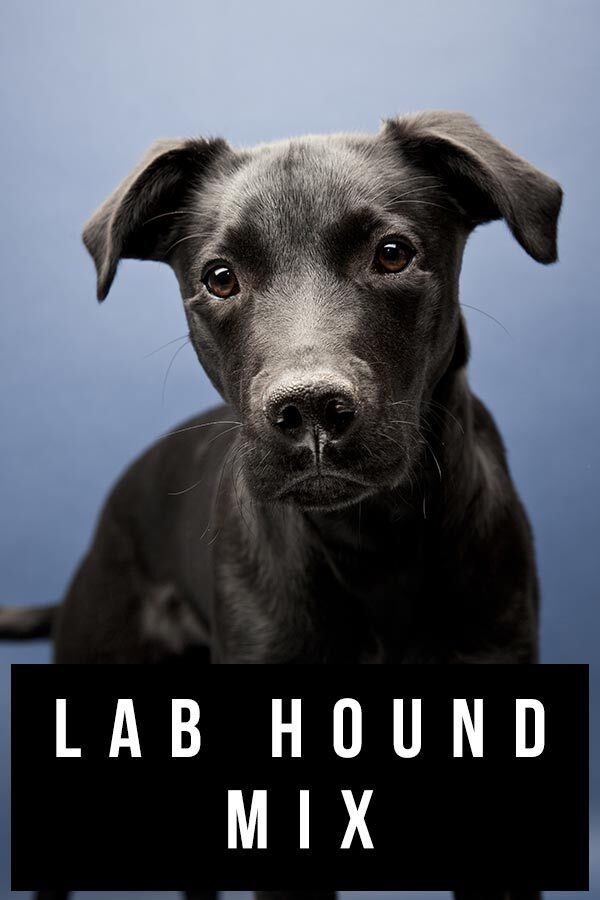
What to Expect From a Lab Hound Mix
Lab and hound mixes go by a variety of names, including Labbe, Bassador, and Dachsador, depending on which hound is mixed with the friendly and popular Labrador Retriever. But, this means each Lab Hound mix is very different from the next.
A mixed breed dog can inherit any traits from either parent used. So, a puppy could be more like its Lab parent, or much more like its hound parent. To get a better idea of what your Labrador hound mix will be like, you should take a look at its parents. Remember, it could be any mix of the two. Later on in this guide, we’ll look at some specific examples of Lab hound mixes. But for now, here’s a more general idea of what to expect from this cross.
Lab Hound Mix Appearance
The appearance of a mixed breed puppy like this could be any blend of its two parents. To predict how your puppy will look, examine his parents to see what traits he could inherit. Labradors are medium sized sporting dogs.
Their coats come in three colors: yellow, black, and chocolate. Their “all-weather” fur is both short and thick. You could have a black Lab hound mix, inheriting the Labrador color – or something with more complex patterning.
There is a slight difference between the working Lab appearance and the show Lab appearance. But, you can read about this more here. Hounds are a diverse collection of dogs that are segmented into three categories. Within these categories exist many distinct breeds of hound dogs, with varying points of origin. So, it’s really hard to generalize a hound appearance. You will have more luck predicting your puppy’s appearance by looking at the specific hound used as a parent.
Lab Hound Mix Temperament
Before we examine the different Labrador retriever hound mix combinations, it should be noted that the offspring of Labs and hounds will reflect the unique temperaments of their parents.
In this case, size doesn’t matter! Whether you have a small Lab mix or large Lab mix, a black Lab hound mix or a yellow one, the temperament is contingent on his parents’ DNA.
Keep in mind, however, that temperamental traits are inherited in a random fashion, and can only be “predicted” in broad, general terms. No one can guarantee with certainty the precise combination of traits that a Labrador Spaniel mix, Bluetick Lab mix, or Bloodhound lab mix will inherit, nor how these qualities will be expressed.
It is nature’s little secret as to how the bundles of each breed’s genetic information will mix and match to create a unique cross breed canine.
Here’s a general look at Labrador and hound dog temperaments to help.
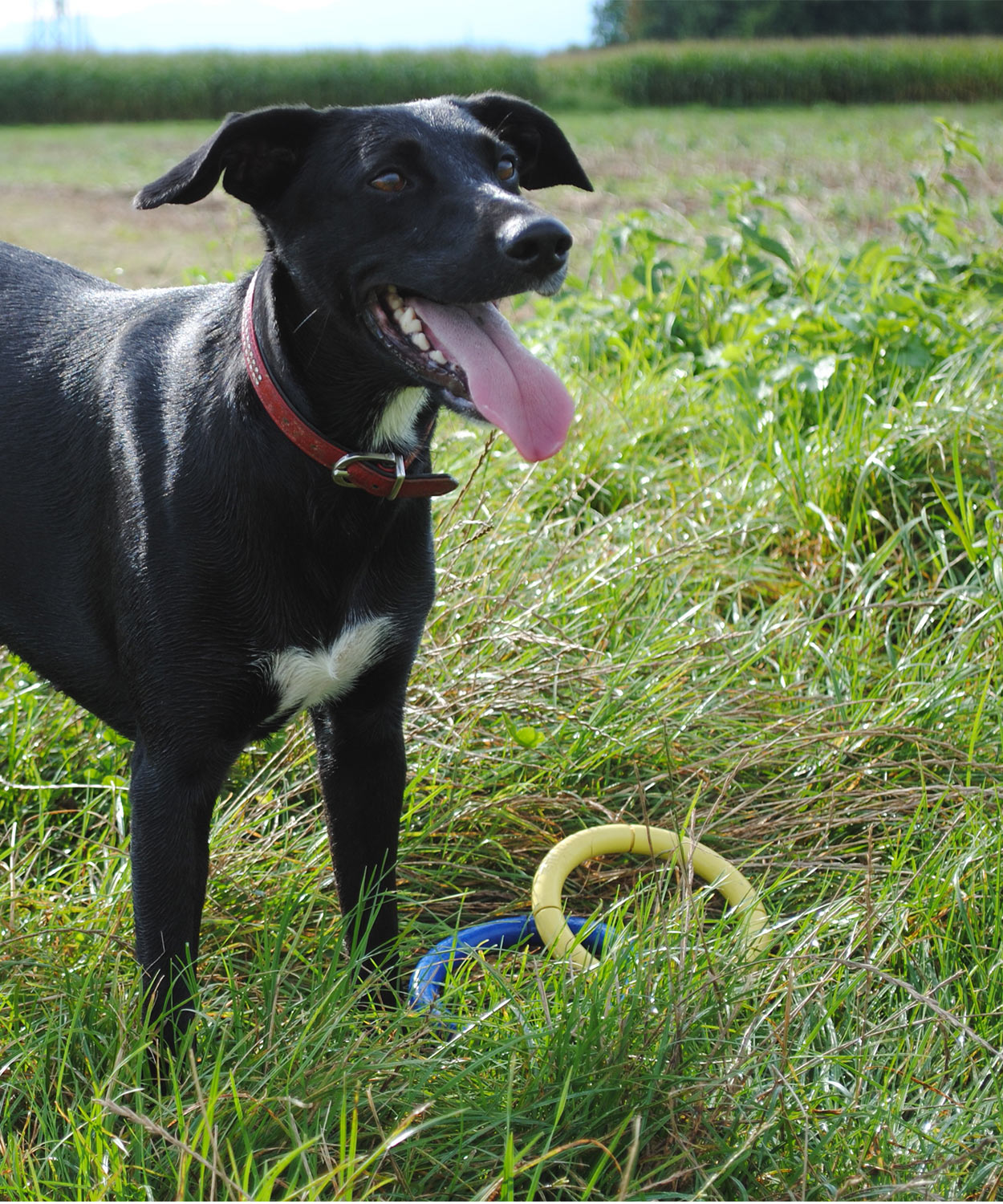
Labrador Temperament
With a sunny, affable personality, Labs are easy to get along with, take well to training, and are eager to please: it’s a win-win situation for all involved!
It’s no wonder they’re America’s favorite dog.
With an impressive energy level, Labs are a popular choice for law enforcement, search-and-rescue, and service dog duty.
Labs are good companion animals for families, but don’t expect the trusting, affectionate Lab to be a ferocious guard dog; it’s just not in their nature!
Hound Temperaments
Hounds are infamous for using a keen sense of sight and/or smell to pick up on a hunter’s intended prey. Some hounds complement their fine-tuned sensory ability with an amazing gift of speed.
Dogs in the sighthound category excel at using their laser-like sight to focus in on and stalk prey.
In contrast, pooches in the scent hound category use their superior sense of smell to help locate game. Due to the valuable nature of their acute sense of smell, scent hounds are also used to find missing persons.
Some experts consider hounds who follow prey using both the senses of sight and scent a distinct category.
But all are active, intelligent, and alert.
Some dogs in the hound group are known for a unique trait known as ‘baying’, which is a loud and distinct vocal emanation. Not everyone is fond (or tolerant) of baying, so it’s best to hear it first hand before bringing such a hound home.
Lab Hound Mix Socialization
No matter which hound breed is used in your Lab hound mix, it’s important to socialize your dog well.
Proper socialization as a puppy helps to ensure adult dogs grow to be happy, confident, and friendly.
It will help to minimize aggression towards people and other animals, particularly fear-based aggression.
So, no matter what Lab hound mix you get, make sure to socialize them well to as many new things, people, and places as possible before they are 12 weeks old.
Even though one parent will be the Labrador – which is known for being friendly – it still needs to be socialized. The friendliest breeds can still benefit from it!
With the certain uncertainty of mixed breeds in mind, let’s take a look at the profiles of a few Lab hound mix canines a bit more in depth.
Beagle Lab Mix
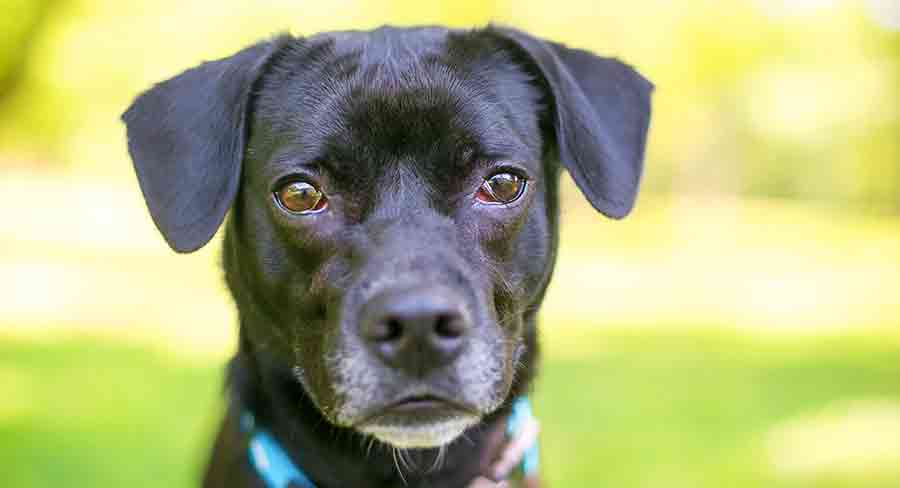
The Beagle Lab mix is also known as a “Labbe.” Beagles are scent hounds that are thought to have originated in Ancient Greece. Hunters used the small dog for its superior sense of smell.
In 2019, Beagles were the 7th most popular breed in the US. The best known Beagle may just be Charlie Brown’s friend, Snoopy. Just like the cartoon Snoopy, real-life Beagles are curious and friendly animals who enjoy being around humans.
Beagles sport a short, heavy fur that comes in colors that include black, tan, red, and white, with blue ticking a possibility. Their coats require regular brushing and can be expected to shed on a seasonal basis.
On average Beagles range from almost 20 pounds up to around 70 pounds, and they typically average one to two feet in height. A lifespan of 10 to 15 years is common.
As a whole, Beagles are prone to hypothyroidism and epilepsy, as well as disc issues. Some Beagles develop a condition known as “Funny Puppy,” where the pup develops at a slower than normal rate. The unfortunate result is a Beagle that is left with a curved back and weakened legs.
If you are interested in a Lab and Beagle mix, a responsible breeder will provide you with health information regarding your puppy, as well as its parents.
Dachshund Lab Mix
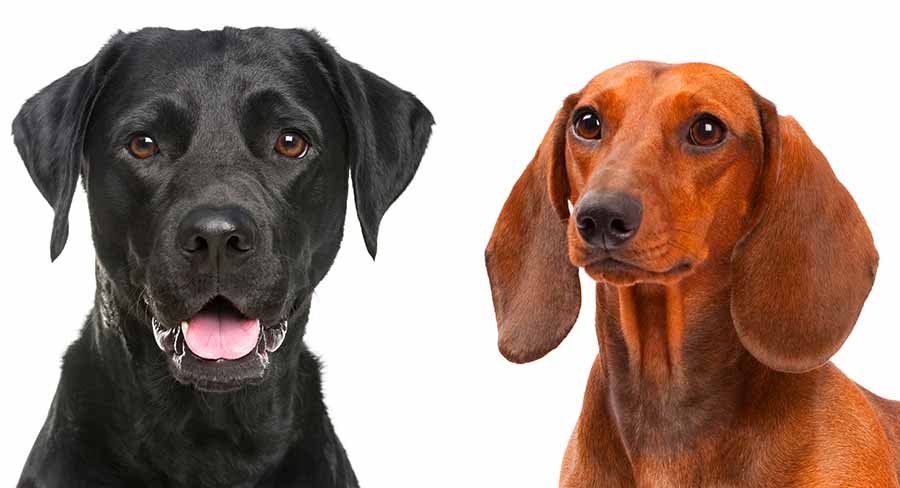
The Dachsador is a Dachshund Lab mix. Dachshunds, fondly known as wiener or sausage dogs, originated in Germany where they were used to hunt underground game. Friendly and lively, they are a small breed, with a medium level of energy.
Their slender, elongated bodies and short legs made them ideally suited for tunneling for rabbits, etc., but today the small breed is mainly known as affectionate and loyal.
They like to bond with their special human. But given their hound ancestry, can be a quite vocal companion. The Doxie lifespan averages from 12 to 16 years.
Dachshund coats come in smooth, wirehaired, or longhaired varieties and require regular brushing. Doxies are low-lying dogs, with standard-sized canines averaging 8 to 9 inches (and 15 to 30 pounds) and miniature sized dogs around 5 to 6 inches (weighing about 10 pounds and under).
Unfortunately these clever and distinctive looking dogs are prone to a few serious health issues. Back problems are common, with over one quarter of the breed (ages 5-9 years old) thought to suffer from back issues.
For this reason Dachshunds should be picked up with two hands beneath the body, and children need to be cautioned against rough play. Epilepsy and blindness are other major health concerns with this breed.
Greyhound Lab Mix
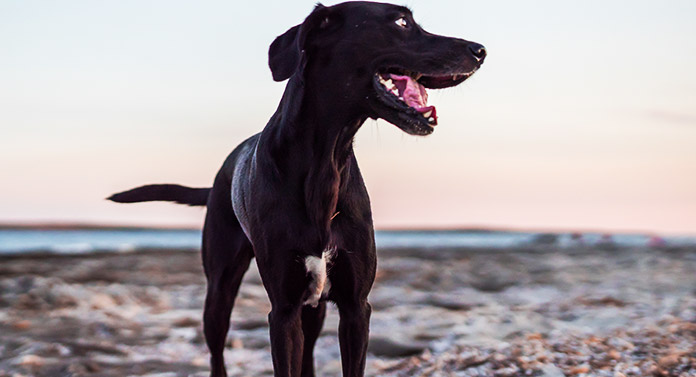
The elegant, beautiful Greyhound is a large breed with a medium level of energy. This uniquely aerodynamic, active dog requires regular exercise but can maintain a status as a house dog quite happily.
Greyhounds can be successfully trained using supportive and positive methods, but all hounds are known to have a bit of a renegade streak in their personality!
Basset Hound Lab Mix
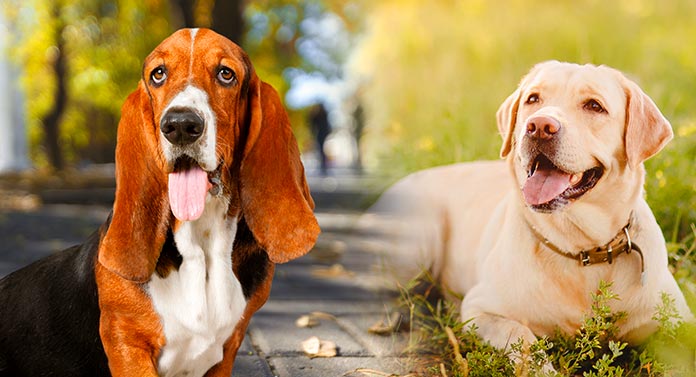
With its big, droopy ears and solid, low-lying body, the wrinkly Basset Hound is an adorably picturesque dog. As a result, the Basset Lab mix appearance is a one-of-a-kind look.
You’ll find that this patient dog is easy to train, and requires quite a bit less physical stimulation than his scent and sight hound brethren. As an added bonus, this medium-sized dog is not as vocal either!
His smooth coat sheds seasonally, and weekly grooming is enough to keep him handsome and trim. Bassets are either tri- or bi-colored with black, white, tan, and red colors distributed randomly on the coat.
Bloodhound Lab Mix
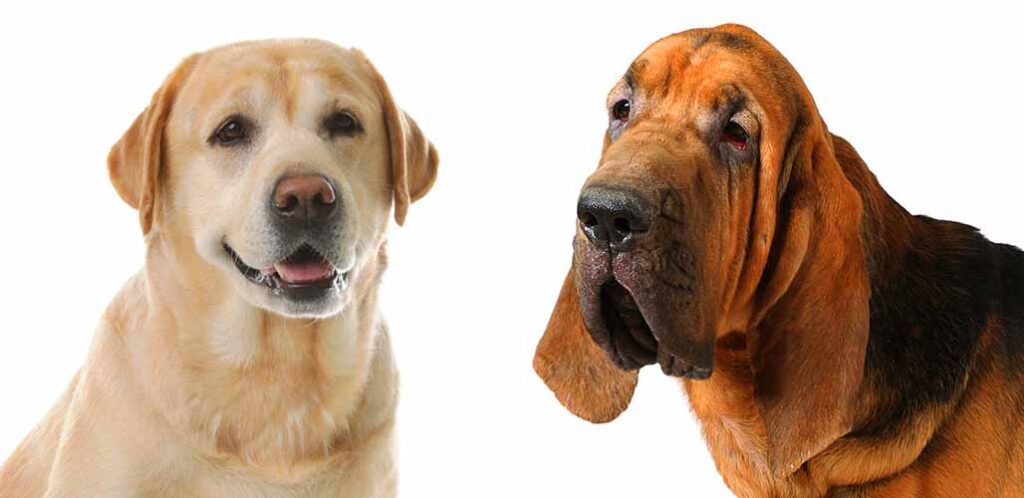
The Bloodhound Lab mix, AKA Labloodhound, is a big dog who can reach nearly 30 inches tall and top out at over 100 pounds. He is a sturdy, heavyweight dog with a lifespan of approximately 9 years and an endurance level that makes him ideal for search-and-rescue work.
But at home, this dog is a loveable companion, with a temperament not unlike the friendly Lab. He enjoys being in the company of his humans as well as other animals, and is relatively easy to train.
Like the Basset Hound, this scent hound has a signature look. He has wrinkly skin and long floppy ears, and his fur colors include red, tan, liver, and black. But beware, he is a frequent shedder, and should be brushed daily and groomed weekly.
Major health issues include hip and/or elbow dysplasia and heart problems. Eye health is also a concern.
Coonhound Lab Mix
Coonhounds belong to the scent hound group. This All-American dog originated from foxhounds found in Europe.
The Coonhound was bred to do what the Foxhound was not meant to do. Namely, hunt tree-climbing game. Thus, the Coonhound found its purpose hunting game in the US, including possums and racoons.
The six types of Coonhounds include the Treeing Walker Coonhound, English Coonhound, and Plott hound.
Plott Hound Lab Mix
The Plott Hound has the distinction of being North Carolina’s state dog. But this breed is not very well known in the other 49 states.
The Plott Hound is a strong dog, willing and capable of chasing after large animals such as bears and wildcats. He is a sort of gentle giant, though, capable of pursuing large game with a high level of endurance, but also exhibiting a tender streak with his humans.
As you may imagine, this medium-sized dog has a medium to high energy level and needs regular, active exercise in order to remain healthy and happy. This is also a dog that likes to bark, so keep this in mind when considering adding her to your household.
Overall you’ll find this pooch to be a smart, athletic, and highly trainable companion.
Blue Tick Coonhound Lab Mix
Finally, another popular Lab and Hound mix is the Blue Tick Hound Lab mix. The Blue Tick Coonhound has a blue and white ticked coat, that can also have tan coloring mixed in.
This breed is particularly affectionate and loyal to its family. They are also very intelligent, and will pick up new skills quickly.
They have a short, glossy coat. But, this will shed moderately throughout the year, so it isn’t a great breed for people with allergies.
Blue Tick Coonhounds have strong prey drives, so must be socialized well and trained properly from a young age. They also need plenty of exercise in order to avoid destructive boredom.

Free Labrador Updates!
Get my training tips, news, reviews, and the latest from The Labrador Site delivered to your inbox



Hello! I just adopted a wonderful 2 yr old black lab dog from LabRescue. I am convinced she has hound in her because of slightly narrower skull, baying bark. She is the most obedient 2 yr old rescue. She has already had a litter.She looks like a 6-7 month old pup and has gone from 51 lbs at her intake to a shelter (~6/24 )to 45 lbs upon my adoption (10/16). I have questions about what to expect with weight. I feel she could stand to gain a few but of course, I don’t want her to be overweight.She grazes her food and has had issues w/ her spaying incision so not sure impact on eating. Should I get DNA testing and/or just go by sight, energy level, etc.? She is absolutely gorgeous and is friendly with everyone and everything ( except for those squirrels).
Hi Barbara, congratulations on your new arrival! DNA testing can be fun, if you want to give it a try, but it isn’t necessary. I would be guided by your vet in the first instance – a ‘moving in’ check up is a good plan if she hasn’t had one yet. And there’s some helpful advice here on checking your dog’s weight with your eyes and hands, here: https://www.thelabradorsite.com/fat-labrador/ 🙂
Loved this article! I’ve always been fascinated by Lab Hound mixes and this guide was incredibly informative. One thing I wish you would’ve touched on is the potential for allergies in this breed. My friend has a Lab Hound mix and her daughter has severe allergies, but the dog seems to be relatively hypoallergenic. Would love to hear more about that in a future post!
I have a 14 year old lab-border collie mix, a 7 year old lab-coonhound mix, and a 4 year old lab-staffordshire mix. The border collie mix is crazy smart, but also stubborn and independent. She knows exactly what you want, and she’ll probably do it – unless she has a better idea. The staffy mix is calm and obedient and was very easy to train. He’s a bit of a couch potato and a snuggler.
The hound mix is about 70 pounds and taller and leaner than a lab. He’s black with speckled markings on his face, legs, chest, and tail. He is extremely, extremely high energy and gets distracted easily. When he was younger, he would constantly try to escape the house/yard to follow scents, so I had to take many precautions to ensure that he didn’t get loose. To this day, I wouldn’t let him off leash in an unenclosed area. Training him took a lot of time and patience. He barks at and chases squirrels, possums, rabbits, lizards and birds, and I think he believes that if he tries hard enough, he’ll be able to climb trees one day. He does bay; I personally think it’s adorable, but some people may disagree. He is also a very sweet and affectionate dog who still loves to play like a puppy, and if I had to choose a favorite, it would probably be him.
Yes, we adopted a Labrador hound mix 41/2 years ago from a local shelter. She has always gotten along with family members, and family dogs. But recently she has shown signs of aggression. We are in the process of figuring out what has changed. Any help you could give us would be great.
My husband rescued a black lab/hound mix and we just love him. His name is Maximilian Sherlock Bones…Max for short. He was so skinny, shy and scared to death when we got him. His coat was as dull as dull could be. Today he is energetic, friendly, healthy and spoiled rotten! We have always had dogs but This bread is challenging. Luckily we live on 5 acres and he has a black lab to play with next door. He is pretty stubborn but reading this article I see it is common. We lost two Golden retrieves in 2020 so Max had brought so much joy into our lives. He is certainly my husbands dog. He doesn’t want him out of his sight. Love this bread and love his long ears and even his baying.
We recently took home a rescue dog. The shelter didn’t have much info, but thought it might be a lab hound mix. She looks exactly like the black dog in the ‘Labrador temperament’ section (with the tuft of white hair on its chest and the blue and yellow chew toy rings). Can anyone tell us what type of parent hound breed is most likely?
Most likely a coon hound, possibly Treeing Walker. Get a DNA test kit, if you want to know for sure the genetic mix of your dog.
It also looks just like my Walker, lab mix.
We rescued a male black lab mixed breed. He
was year old and we were the fourth owners.
He had three great owners but circumstances
Beyond their control forced them to give
Shadow up. We already had a pure bred yellow English lab and thought that it would
Be great if he had a companion.
It was not long before Shadow let loose
With a very vocal “bay bark” and started
Chasing squirrels. Yes, he has some some coon hound in him. No big deal. He has turned Out to be a wonderful dog. Very smart, A Lovable Lap Dog, very obedient, does well other dogs, and waits for us when we leave him at home. He may
Still have some semblance of a separation
Anxiety as he was “given up” by three
Previous owners, but not a real issue.
Our 12 old yellow’s Health is starting to
Decline and Shadow has helped us deal
With the inevitable.
I have a 6 month old rescued puppy who the adoption agency identified as a Boxer/Yellow Lab mix. My vet does not agree and as a result of reading this post, I am convinced that he is a Lab/Plott Hound mix. He is very stubborn, loves to chase rabbits, chews wood and is adorable. He is brindle with 4 white socks.
He is full of energy and must exercise daily. He was house trained in 2 weeks and is a much loved member of the family. We are working on obedience training which of course means he is very treat focused and learned to beg right away.
I was the happy owner of Abbey a Beagle/Lab mix. She was the sweetest dog ever…everyone loved her and said the same thing about her. Oh, when I got her at a year old she was mischievous and chewed a number of things but got over it as she grew older. She was difficult and strong on the leash but I used a leader for a while and she was great to walk. She was a foodie…she ate whatever she could find. I learned that quickly about her. Once I left 5 lbs of potatoes in a cupboard that she found…ate them all in one sitting; stole loafs of bread and even got into my baking supplies…dragged the bags in the livingroom..well, you can imagine 5 lbs of flour and white sugar all over the floor!! She was smart, happy and so affectionate. She passed away 3 months ago at 14 years old and I can’t explain how much I miss her…she was my “person”. She went everywhere with me!! In a few days, my new rescue is arriving..a Lab/Tree Walker CoonHound. I am so looking forward to his arrival…I think my sweet Abbey would approve!!
I have a 6 month old Black Lab/Walker Coonhound mix and boy oh boy does he give me a run for my money. He’s still a baby, but let me tell ya his nose gets him into big trouble. He’s likes to jump and nibble, but we have him trained to sit, lay and stay (when a treat is involved of course) he definitely has calmed down some, he was the only one in the litter that looked like a walker coonhound. They rest of his siblings were black with some white, not my boy he’s all coonhound. We are not training him for hunting. Buts he’s becoming a lazy butt. He’s still thinks he’s a tiny baby and trying to jump on you while your sitting in a chair.
I have recently got a black lab/walker puppy, named Cooper. He looks exactly like the picture above, all black with the patch of white on the chest and chin. He was 3 1/2 months old when we got him. He is very energetic, has an issue with biting and chewing (of course, he is a puppy) but is destroying my furniture. I have chew bones for him, toys, etc. and still insists on the furniture. He will even go for our firewood. He barks and talks back when I scold him for taking things he shouldn’t have (I actually call him a thief, steals anything he can). He is giving me a workout. He is trainable as he has learned sit command, giving paw, throw a ball and bring it back. He is rough with the kids (I have a 13-year-old and 7-year-old granddaughters who live with us most of the time), constantly biting and nipping at them. I know I have to be patient with him as he is still a puppy but we love him and he is so cute when he sleeps and very calm when he first wakes up but doesn’t take long for him to get his energy going again. I take him for walks as much as I can and he pulls a lot, hope to break him of that. I slipped in the snow this morning from him pulling me so hard.
We got a rescue hound (supposedly a Plott hound, but could be redbone coon hound/yellow lab retriever mix, 3 months old. He responded well to a lot of walks and exercise (and ball tossing, etc.) So, I would guess a lot of exercise should help with your pup, especially when you have a pup teething, etc. A good pup is a tired pup.
My pup never met a stick he didn’t like to chomp on, or leaves he wanted to chase. We were fortunate, as we had a 3/4-acre yard with a fence, so he could roam at will. I think if you can, give your pup as much exercise as possible. My dog would stand at our coat closet at 7:00 PM in the winter, telling me to get up, get my coat and flashlight, and walk him the 2/3-mile around our block in ten-below temps. He’s a little over 4 now, and the best pup I ever had. We still walk around 4 miles a day. Good luck – the hound mix is wonderful. Let the little guy have his nose, take your time walking him…the walk is for him, not you…let him have his nose, and enjoy. Oh, and yes, they have strength and can YANK you while walking, so always keep and eye out for them!
I have Indiana, a 10 year old healthy energetic black lab and red hound mix.
She is STRONG and still can pull me off my feet so I have to walk her with a gentle leader. She is not much interested in birds or squirrels, but if a rabbit crosses our path—all bets are off. She is quite healthy except for a bit of diarrhea now and then. I just give her bland diet for a couple days and we’re fine.
She is very affectionate, eager to please and smart enough to be manipulative. I’d have another of this mix in a heartbeat.
One more thing—she is obsessed about self care. She cleans herself like a cat! She never smells and never needs baths. Just a brushing and freshening from time to time. I think it’s the extremely short fine fur.
(Our last lab was a lab/shepherd mix. She was sweet too. Lived to 15 with no health issues— just had no real outgoing personality)
So good to read about others’ experiences with their mix black lab and blue tick coonhounds. We’ve had other dogs with black lab mixes and this is our first experience with this particular mix. Abbey is 1.5 years old now . It didn’t take long to see her stubborn streak. What surprised us is her propensity to steal and hide. She is loving and mostly obedient but if she finds a treasure on her own she is not only reluctant to give it up but will immediately seek another like it. E.g. the toilet paper. She loves fetch and will relinquish the toy so she can play again
But defiant. She’ll keep her eyes on us while scratching her back in order to delay responding to a sit command. The other thing I heard from others in this forum is the dog enjoys jumping up. Its a serious concern for me as we have an ice and snow covered yard from fall to winter. Abbey will run full blast at me from behind playfully I think and then jump really high at my back. A few times she has knocked me off my feet and it’s a real concern. I don’t normally playfight with her so not sure where this comes from. Anyway as I write this she is doing her impression of a fireside hound. Maybe some of these behaviors will be resolved by 4 years old. Any input is welcome.
Hey everyone! I have a beautiful little Girl named Ellie Mae. She is a Black Lab mixed with Coon Hound. What a great girl she is! She is 12 1/2 years old and so smart! Of course she was a young whipper snapper as a puppy, but once she was 4 she began to settle down and was more calm, and layed back. She is a good RULE follower. She was potty trained with no accidents at 3 months old. She can sit, High Five, Shake, Roll over, and she understands what “Belly Rubbins” means.. She has a lot of traits from both Breeds of dogs and has been a joy to have in our family! Just over these past 6 months has she began having Hip problems along with Dead tail, and having trouble walking up and down steps. We consider ourselves very lucky as labs are prone to such issues. She will be 13 in a few months so we know that her life is nearing. We love her so much and she is one of children and will be greatly missed when she is gone.
Just posted a couple questions about Abbey our blue tick coonhound. We love her dearly and didn’t want to sound negative
We live on a farm and if she’s in the house when my husband comes home from work she’ll either hear his truck or see the headlights from 1.5 miles away. She’ll stand in front of picture window till she sees him in the yard. Tail wagging is an understatement. When he parks his truck she flies down to the entrance downstairs and waits for him or bugs me till he comes in. Nothing better after a hard day to get that unreservedly loving and happy greeting
5
We have a 1yr old ‘Molly-Monster’.
A.k.a. Junk-yard-dog, a.k.a. Labloodhound.
‘Molly’ came from an unintended mating of bloodhound mom (mottled brown & black) & black lab dad. Her mom was small, about 50lbs; assume dad was normal size for lab. Like her mom, Molly is around 50-55 lbs, smaller & slimmer than most labs.
She is black with brownish mottling here & there, most noticeable in sunlight. She has the hound’s longer, floppy ears, with wide eyes that show alot of white.
She is full of energy, fun loving, thieving, very vocal, and quite obstinate. It seems she hit the mark with both parents’ traits. Loves her people, loves chewing everything (even rocks😕), laying in the sun, and following scents. We’re still working on fetch – she loves chasing things, just hasn’t learned to relinquish her prize yet. She ‘talks’ back when scolded, thinks everything is hers to chew on (including her people😒), and generally acts like a ‘junk-yard’ dog. But when she’s ready for sleep, she becomes the sweetest lap-dog ever🤗. She’s up at dawn, thanks to the hunting-hound instincts I guess. But, by 10pm she’s done for the day. Pretty regularly now, she’s in bed by 11pm, not to be disturbed😴.
We previously owned a purebred black lab that was The Best Dog Ever – smart, loving – EASY. Needless to say, having a ‘Molly’ has been quite different, and NOT easy.
But, somehow, she has crawled, jumped, scratched, bitten, sniffed, and chewed her way into our hearts 💕.
We have a 1/2 chocolate lab 1/2 restick coonhound. He is full of energy and cannot be let off leash. He is very attached to my husband and I and our three kids (17,19,21) He has recently started to calm down some at 4 years old. His favorite thing to do on a walk is smelll everything. He pulls like a ox, but is getting better walking when I carry treats in my pocket and my clicker. We cannot run with him on the leash, as he will treat us like another dog and jump up and nip our arms. He is very smart and understands several words including;walk, Beach (his favorite place-he likes swimming and retrieving sticks thrown in the water), go, treat,sit and down. He gets along with our two cats who will sometimes bully him to which he will sometimes chase for fun. He is sometimes too smart for his own good. He’s very muscular and loves most people! He is prone to ear infections and and skin irritations and will chew his hindquarters if bored. I have been giving him a fish oil capsule with a dab of peanut butter on his nightly organic dog treat and it has improved his skin irritations tremendously and his coat is so shiny! I think it has also helped some with his tendency to get ear infections. I wish I could post a picture of him with this comment as he is super cute with his sad like eyes and droopy jowls with lab like ears and big lab feet!
I have a hound/black mix. DNA came back 50/50. She is all black. She is all hound with personality and behaviors. There is not even one retriever behavior. I wish I knew what kind of hound. She has a hound bark but does not bay. She runs very fast with hound hips. She loves to hunt ground critters in particular like varmits. She will run away 100% of the time but come back only when she wants to if she gets loose. We have to go to dog park everyday to keep her happy and have invested in an expensive fence which she used to jump over so had to get creative. She lives in the house. She is very independent. She will go off on her own in the house and at the park. People will ask, “Whose Dog is that?”. Oh yeah, she will just do what she wants and is often far away from us but she knows where we are even when I can not see her and she will randomly check in. We had Retrivers and Springers. She was a learning experience. Mellow and quiet in the house. Calm around people, dogs, and cats. She loves the heat even being Black which is a mystery. She will lay in the sun and sit and stare at a fire. She will go into water for a drink or to cool herself but does not want to swim at all. I have found her in a middle of the park with her body half dug into the ground and she pulled out some critter under there. The lab part seems untrue to me. Makes me wonder about DNA testing. This is why I am reading this site.
Ginni – You & I have the same problems, wonderful dogs with no “history”. My dog looks just like the picture too. I had my Nell’s DNA done out of curiosity & it came back Alaskan Malamute, Beagle & a little German Shepard. I phoned them, saying must be some mistake. They said no. Nell is tall, rangy, sweet & wonderful. Definitely a nose dog, but malamute – don’t see how.
Would like to know what kind of lab mix the dog pictured with your article about lab hound mixes is. She looks just like my lab mix rescue & I would like to know more about my dog. I enjoyed reading the column. Thanks
We just got a rescue from Tennessee and looks like the picture also . Did they respond as to the hound/lab mix?
Have a yellow lab/ plott hound mix (could be redbone coon hound, not 100% sure). Perhaps a little sharpei, possibly some terrier. Friendly, loves women, children, but sometimes not so much men. High energy, needs a lot of walks and play. He has his schedule: beach walk 1st thing, 2nd walk around 10:3O AM, etc. Great companion!! Loves to play, but given his nose, can’t let off leash unless we’re at a dog park. Best dog I ever had.
What lab/hound mix is the dog in this article. My dog, Eli, looks exactly like the one pictured with the white on muzzle and blaze on chest. He is a rescue from Georgia. I thought he was a German Shorthaired Pointer but now am wondering. He has a wonderful personality and is definitely a hunter. He only barks occasionally and has a cropped tail. He runs like the wind and jumps and bounces. He actually will spring up into a tree if he sees a squirrel but isn’t too interested in birds. He’s around 3 years old.
We have a hound lab mix. When he was a pup he looked liked a yellow lab but now has grown into more of a hound body, long legs, small feet. Has a hound bark but only if you ask him to tell you a story. Very funny.
If at a dog park, he sometimes “barks” at the other dogs if they are not running. Very funny to see the reaction of the other owners when they hear his baying. Also true to most hounds, he is not that fond of water. Have to watch him around deer though. He can run like the wind and we must keep a close eye on him.
Have recently bought a yellow lab, English style, and hoping she will become my duck dog.